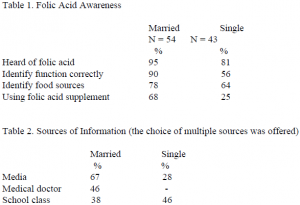Natasha Bushnell & Mariana Chiriac with Nora Nyland, Food Science and Nutrition
One of the B vitamins, folic acid is involved in DNA synthesis in the human body. This nutrient becomes crucial during the embrionic development of the fetus during a pregnancy. A maternal deficiency of folic acid, added to a genetic predisposition, has been linked to the development of neural tube defects in the fetus (e.g. spina bifida and anencephaly). These conditions re results of an incomplete development of the central nervous system, causing 2500 to 3000 infants in the US to be physically and mentally impaired every year.
The key to preventing such debilitating conditions is mainly held by women of childbearing age. The FDA currently recommends that all women of childbearing age supplement their diet by 400 mg of folic acid per day. However, because the fetal nervous system is formed by the end of the first month of pregnancy when a woman generally does not know that she is pregnant), all women who could potentially become pregnant need a folic acid supplement daily, well before a pregnancy may occur, or else it might be too late.
It is with the above concern in mind that we wanted to measure how much BYU females know about folic acid and its supplementation. This knowledge would lead to a folic acid awareness campaign that would help young mothers have healthier babies. We wanted to observe two populations: married versus single females and see if there is a difference in their level of awareness. We had a married female sample of 60 subjects from the Wymount housing, and a single female sample of 54 subjects from the Deseret Towers housing. We designed a telephone survey containing 11 multiple choice or yes/no questions like “have you ever heard of folic acid?”, “which of the three options below is a function of the folic acid?”, “where have you heard about it?” and “which of the following foods are rich in folic acid?”.
The results of the survey showed that 95% of the married females had heard of folic acid, 90% could correctly recognize its main function in the body, 78% could identify foods that are good sources of folic acid and 68% were supplementing their diet with folic acid. The results for the single women showed that 81% had heard of folic acid, 56% could identify correctly its main function in the body, 64% could identify foods that are a good source of folic acid and 25% were supplementing with folic acid.
Most single females had heard about folic acid in a school class (46%) (e.g. FSN 100) or in the media (28%), while most married females had heard about it in the media (67%), from their medical doctor (46%) or in a school class (38%), or all of the above. While undoubtedly both medical doctors and school professors fulfill their duty in teaching about folic acid, it seems that the media has a powerful impact in educating young females about the importance of folic acid. A folic acid awareness campaign on BYU campus might be a viable public health strategy.
When comparing the level of folic acid awareness between married versus single females who had taken FSN 100 (basic Food Science and Nutrition class) previously, we noticed that 95% of married females knew exactly what folic acid was, when it is to be taken and how much. For single females, the same level of awareness was encountered in 87% of those who had taken FSN 100.
Some of the problems we experienced in administering the survey had to do mostly with the sample size and data analysis. Working out all the details of the survey and the time required to obtain permission to proceed with it, left us with administering the survey during spring term, thus with a smaller sample than we hoped for. Another thing we did not account for was how complex our data proved to be, even after we simplified the survey to the maximum, while still making sure we obtained all the data needed. We were only able to analyze individual questions and compare the two sample proportions for those individual questions in order to find out a p value.
We feel that more complex statistical analysis of our data needs to be done in order to have solid scientific support of our results, and with this goal in mind, we are planning on working with the statistical programs available to graduate students. However, what we know so far has helped us draw some interesting conclusions, and will prove of benefit in taking action to increase folic acid awareness.
References
- Standing Committee on the Scientific Evaluation of Dietary Reference intakes. 1998. Folate. Diet Ref Int 8-25-8-31.

